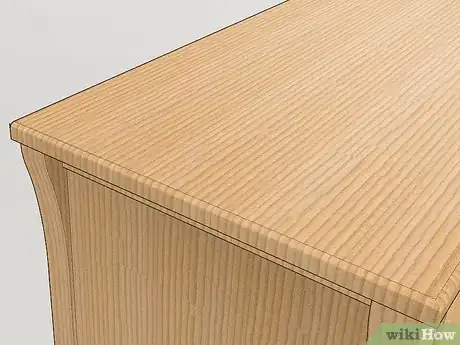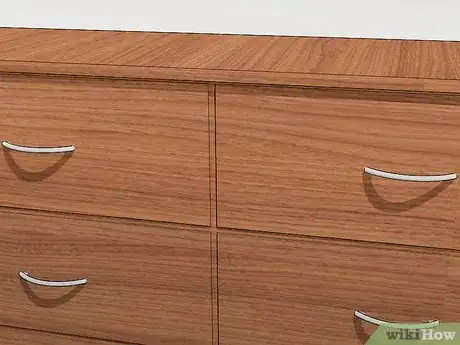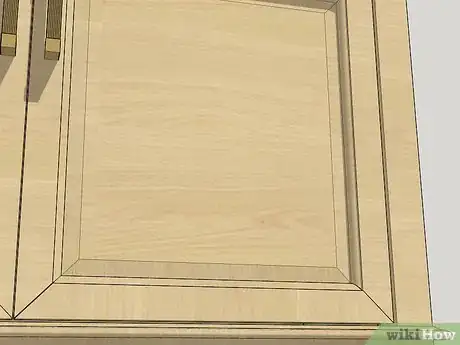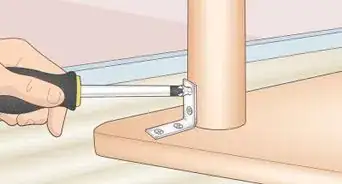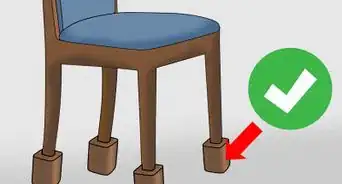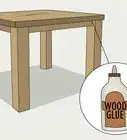This article was co-authored by wikiHow Staff. Our trained team of editors and researchers validate articles for accuracy and comprehensiveness. wikiHow's Content Management Team carefully monitors the work from our editorial staff to ensure that each article is backed by trusted research and meets our high quality standards.
This article has been viewed 45,379 times.
Learn more...
There are a lot of different types of wood used to make furniture, which can make identifying wood types in furniture tricky. Fortunately, you can identify what kind of wood your furniture is made out of by looking at the colors, grain pattern, and texture of the wood. To help you out, we've put together this wood identification guide for furniture that you can use to figure out what type of wood your furniture is made out of.
Steps
Recognizing Common Types of Softwood
-
1Examine the wood for scratches and dents to determine if it is softwood. Harder woods are more resistant to scratches and dents, so if you don’t see any, the furniture may be made out of hardwood. A piece of furniture that has many scratches and dents may be made out of softwood.[1]
- Try scratching an inconspicuous area of the furniture with your fingernail if you don’t notice any marks to see if it is easy to put a mark into, which can indicate that it is made out of softwood.
- Softwoods come from conifers like pine, redwood, and cedar.
-
2Identify pine by its yellow color, straight grain, and abundance of knots. Feel for a smooth grain texture if the wood looks yellowish and has a straight grain. Look for darker growth rings in addition to an abundance of knots.[2]
- Remember that if your furniture is stained or weathered, it will be harder to tell what kind of wood it is based on the color. You can still try to determine what it is from other features like the grain pattern.
- Pine is used frequently for indoor rustic casual furniture like tables and dressers, for example.
Tip: It is extremely helpful if you search for images of different wood types on the Internet so you can look at them and compare their appearance to your piece of furniture.
Advertisement -
3Spot cedar by its rich red color, straight grain, and unique scent. Feel the grain to check if it is smooth if the wood looks reddish and has a straight grain. Smell the wood closely for an aromatic woodsy scent for a key giveaway.[3]
- Cedar is commonly used in outdoor furniture because of its weather resistance, as well as to build indoor furniture like wardrobes and chests because of its moth repellent properties.
-
4Recognize redwood by its dark red color and wavy grain. Look for redwood’s signature marled reddish-brown and mahogany colors and curvy, intricate grain patterns. It is similar in appearance to cedar but has a darker, more elegant red color.[4]
- Redwood is commonly used for outdoor furniture because it is very weather-resistant.
- If you can’t decide whether a piece of wood furniture that is red is made out of cedar or redwood, smell it. Redwood does not have the woodsy aromatic scent that cedar does.
-
5Identify Douglas fir by its light brown color and its tight straight grain. Douglas fir can have hints of red or yellow between its growth rings. The grain pattern is usually very subtle and typically has knots in the growth rings.[5]
- Douglas fir is usually used for cheaper applications, so if your furniture is not expensive and it is made out of softwood, it might be made from Douglas fir. Painted furniture is often made out of douglas fir as well, because of the fact that the grain pattern is not super prominent.
Identifying Common Hardwoods
-
1Inspect the wood grain for textures that indicate it is a hardwood. Softwoods usually have smooth grain patterns, while hardwoods have rougher, more porous patterns. Look at the grain and feel it with your fingertips to determine if it has the texture of a hardwood.[6]
- Hardwoods come from flowering trees like walnuts, oak, and maple.
- Some hardwoods, such as maple, have smooth grain patterns like softwoods do.
-
2Spot oak by its light brown color, straight grain, and visible growth rings. Look at and feel the grain to see if it is porous. Verify that the wood has darker growth rings and very few knots.[7]
- Both red oak and white oak are commonly used in furniture and have a similar light brown color. However, as the name implies, red oak can have some hints of red in it.
- Oak can be used to make all kinds of furniture, including built-in furniture like cabinets. It is also commonly used for homewares like cutting boards.
Tip: Oak sometimes has an almost-reflective appearance when you look at it in the light. This occurs when oak is cut using a technique called quartersawn, which shows off its rays, or cells that run perpendicular to the growth rings.
-
3Recognize maple by its light creamy or yellow color and unusual grain patterns. Look for unique patterns in the grain and a lack of straight grain to spot maple wood. It is a light creamy color when it is fresh and darkens to more of a yellowish color over time.[8]
- Maple is mostly used for indoor applications where the woodgrain is highly visible because of its unique and beautiful grain patterns. For example, high-end dining room tables and chairs are often made out of maple.
-
4Identify walnut by its dark tan or chocolate brown color and straight grain. The most common type of walnut used in furniture is black walnut, which sometimes has streaks of purple or green mixed in with its rich brown color. Look for slightly darker growth rings mixed into the straight grain to spot walnut furniture.[9]
- If the wood is from a young walnut tree that was still growing, it can also have pale yellow growth rings that contrast the dark growth rings.
- Walnut is expensive, so it is typically only used for high-end luxury furniture. It is often used in ornate carved furniture, such as mantelpieces or headboards.
-
5Recognize mahogany by its pinkish or reddish-brown color and smooth texture. Mahogany has a fine long grain with few knots, so look for these qualities in addition to the color and texture. It starts out almost pink in color and darkens over time, so consider the age of the furniture when you are deciding if the color indicates that it is made out of mahogany.[10]
- Mahogany is used to make many types of furniture and is often used as a cheaper alternative to walnut.
-
6Look for a very light color and wide spacing between growth rings to spot ash. Ash tends to be beige or very light brown. The growth rings are typically light brown as well and often almost blend into the surrounding grain.[11]
- Ash can look similar to oak, but generally has less brown hues in its color and never has red hues.
-
7Identify beech by its cream tone and straight and tight grain pattern. Look for yellow or reddish hints in the cream color. The grain pattern often has gray flecks in it as well.[12]
- Beech wood is often used to make curved pieces of furniture, such as curvy chairs, because it bends well using steam.
Spotting Engineered Wood
-
1Look at the end grains of the wood to see if there is exposed engineered wood. Inspect the wood grain pattern on top of the wood and follow it with your eyes to the end of the piece. Check if the grain goes all the way through the piece of wood or if it is missing a grain pattern and looks like fake engineered wood.[13]
- If the end grain looks different and doesn’t have the same wood grain pattern wrapping around, the furniture is probably made out of engineered MDF, OSB, or particleboard, rather than a solid piece of wood, and laminated with veneers made to imitate the look of wood.
- If your furniture is made out of laminated MDF, OSB, or particleboard, the end grains will usually look like sawdust or wood shavings compacted and glued together. They could have a strip of veneer glued to them to hide the engineered wood’s appearance, but the grain pattern won’t match that on the surface of the furniture.
-
2Check for repeating wood grain patterns to spot veneers. Look at the wood grain patterns on the top, sides, and front of your piece of furniture. Repeating patterns mean that it is veneered and not made out of a solid piece of wood, which would have unique wood grain patterns all over.[14]
- Veneers are typically made from either printed laminate or wood-colored plastic made to resemble wood grain.
-
3Examine the sides and bottoms of drawers to discover fake wood. Open up drawers if the furniture has any and look at the side pieces, the bottoms, and the backs of the front pieces. Look at the wood grain and end grain patterns to determine if the drawers are made out of solid wood or veneered engineered wood.[15]
- If you don’t spot any signs of man-made wood composites or plastic veneers meant to imitate the appearance of wood, you can proceed to try and identify the type of solid wood used to build the furniture. If you do notice that your furniture is made out of engineered products, there is nothing to identify.
References
- ↑ https://cutthewood.com/diy/how-to-tell-wood-types
- ↑ https://www.dwell.com/article/wood-identification-pine-oak-maple-walnut-cherry-2a2cdda6
- ↑ https://builderology.com/types-of-wood/
- ↑ https://builderology.com/types-of-wood/
- ↑ https://www.dwell.com/article/wood-identification-pine-oak-maple-walnut-cherry-2a2cdda6
- ↑ https://cutthewood.com/diy/how-to-tell-wood-types
- ↑ https://www.dwell.com/article/wood-identification-pine-oak-maple-walnut-cherry-2a2cdda6
- ↑ https://www.dwell.com/article/wood-identification-pine-oak-maple-walnut-cherry-2a2cdda6
- ↑ https://builderology.com/types-of-wood/
- ↑ https://builderology.com/types-of-wood/
- ↑ https://www.dwell.com/article/wood-identification-pine-oak-maple-walnut-cherry-2a2cdda6
- ↑ https://builderology.com/types-of-wood/
- ↑ https://www.wood-database.com/wood-articles/wood-identification-guide/
- ↑ https://www.wood-database.com/wood-articles/wood-identification-guide/
- ↑ https://www.erinspain.com/wood-furniture-real-or-fake-how-to-tell/




